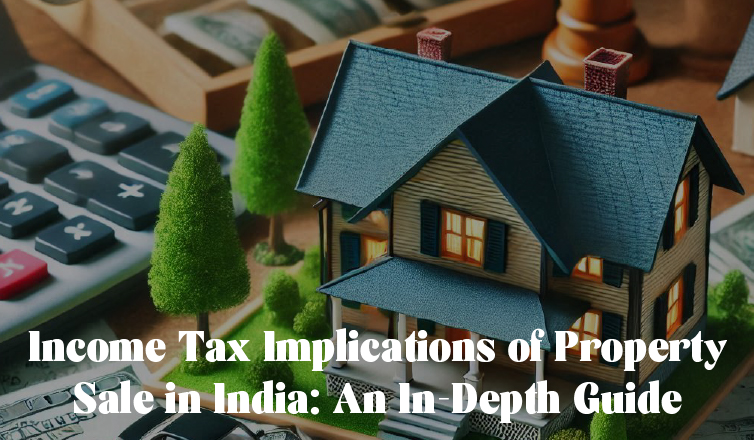Income Tax Implications of Property Sale in India: An In-Depth Guide
Selling property in India can trigger significant tax obligations, particularly in terms of capital gains tax. The nature of the capital gains tax (CGT) on property sales depends on several factors including the type of property, holding period, seller’s residential status, and eligibility for exemptions. Non-resident property owners also face distinct tax rules. With the complexity of tax laws surrounding property sales, understanding these intricacies is key for anyone looking to sell property in India, whether for personal or investment purposes. This guide will explain in simple terms the different components of tax law relating to property sales, from capital gains tax calculation to exemptions, Tax Deducted at Source (TDS), and special considerations for non-residents.
By CS Kamal Sharma January 10, 2025
1. Nature of Capital Gains on Property Sale
Capital gains tax is levied on the profit made from the sale of capital assets such as property. The key factor that determines how much tax is payable is the duration for which the property was held before being sold. There are two categories of capital gains:
Short-Term Capital Gains (STCG)
-
Holding Period: If the property is held for 24 months or less, the gain is classified as Short-Term Capital Gain (STCG).
-
Taxation: STCG is taxed at the seller’s applicable income tax slab rate. In simpler terms, it means the tax rate depends on the total income of the seller. If the seller’s total taxable income puts them in the 30% tax bracket, the STCG will be taxed at 30%.
For example, if someone with a high income sells a property within 24 months, they will be taxed based on the normal income tax slabs, possibly at a rate of 30%.
Long-Term Capital Gains (LTCG)
-
Holding Period: If the property is held for more than 24 months, the gain from the sale is classified as Long-Term Capital Gain (LTCG).
-
Taxation: LTCG is taxed at a flat rate of 20%. However, this comes with indexation benefits, which help reduce the taxable capital gain by adjusting the property’s acquisition cost for inflation.
If the property was bought on or after July 23, 2023, there are additional choices for the seller:
-
12.5% tax on LTCG without indexation.
-
20% tax with indexation (if purchased before July 23, 2023).
The concept of indexation is essentially the process of adjusting the purchase price of the property based on inflation, making the original cost of the property higher, and thus reducing the taxable gains.
2. Computation of Capital Gains
The process of computing capital gains involves a few key steps. These steps are applicable for both LTCG and STCG.
For Long-Term Capital Gains (LTCG):
-
Full Value of Consideration: This is the sale price of the property, i.e., the amount the seller receives from selling the property.
-
Indexed Cost of Acquisition: The original cost of acquiring the property is adjusted for inflation using the Cost Inflation Index (CII), which is published annually by the government. This step ensures that the acquisition cost increases, reducing the taxable gains.
-
Expenses on Transfer: These include expenses such as brokerage, legal fees, stamp duty, and any other costs incurred during the sale.
-
Net Capital Gains: The taxable capital gain is the remaining amount after subtracting the indexed cost of acquisition and transfer expenses from the sale price.
For Short-Term Capital Gains (STCG):
-
Full Value of Consideration: This is simply the sale price received from the sale.
-
Actual Cost of Acquisition: The original purchase price of the property.
-
Expenses on Transfer: The costs related to the sale, such as brokerage or legal fees.
-
Net Capital Gains: The taxable STCG is the amount left after subtracting the original cost of acquisition and expenses from the sale price.
3. Exemptions from Long-Term Capital Gains (LTCG)
While LTCG tax is levied at 20%, there are exemptions available under specific conditions that can help reduce or defer the tax liability.
Section 54: Exemption for Reinvestment in Residential Property
-
Criteria: Under Section 54, a seller can claim an exemption from LTCG if the capital gains are reinvested into purchasing a new residential property.
-
Timeline: The new property must be purchased 1 year before or 2 years after the sale of the original property. If constructing a property, the construction should be completed within 3 years.
This exemption allows property owners to reinvest the proceeds from selling one residential property into another residential property, deferring the tax on capital gains.
Section 54EC: Investment in Specified Bonds
-
Criteria: This section allows sellers to claim LTCG exemption if they invest the capital gains in bonds issued by entities like the National Highways Authority of India (NHAI) or Rural Electrification Corporation (REC).
-
Timeline: Investment must be made within 6 months from the sale of the property.
-
Cap on Investment: The maximum amount that can be invested in these bonds is capped at ₹50 lakh per financial year.
Section 54F: Reinvestment in Residential House
-
Criteria: This section applies when the seller sells a non-residential property (e.g., land or commercial property) and reinvests the proceeds in purchasing a new residential house.
-
Timeline: Like Section 54, the new property must be purchased 1 year before or 2 years after the sale. If constructing the property, the construction must be completed within 3 years.
Budget 2023 Amendment: ₹10 Crore Cap on Exemption
-
The Budget 2023 amendments imposed a ₹10 crore cap on the exemption under Sections 54 and 54F. This means that only up to ₹10 crore of capital gains can be exempted under these sections; beyond this, tax will be applicable.
4. TDS (Tax Deducted at Source) Applicability
The buyer of the property is responsible for deducting a certain percentage of the sale amount as Tax Deducted at Source (TDS) and depositing it with the government. Here’s how TDS works:
For Resident Sellers:
-
Threshold: TDS is applicable if the property value exceeds ₹50 lakh.
-
Rate: The buyer must deduct 1% TDS on the total sale consideration.
For Non-Resident Sellers:
-
Rate for LTCG: For non-resident sellers, the TDS rate is 20% on the sale consideration for LTCG.
-
Rate for STCG: For STCG, the TDS is deducted at the applicable income tax slab rate for non-residents, which is usually higher than the rate for residents.
The buyer is responsible for deducting the TDS before making payment to the seller. The buyer must then deposit this TDS with the government and issue a TDS certificate (Form 16B) to the seller.
5. Tax Implications for Non-Residents
Non-residents selling property in India are subject to different tax rates. The key points to understand are:
Long-Term Capital Gains (LTCG) for Non-Residents:
-
Tax Rate: Non-residents are taxed at 20% for LTCG arising from property sales. They do not benefit from indexation unless they choose a lower tax rate under Section 115E.
Short-Term Capital Gains (STCG) for Non-Residents:
-
Tax Rate: For STCG, non-residents are taxed according to the applicable income tax slab rates.
Double Taxation Avoidance Agreement (DTAA):
-
Non-residents may be able to reduce their tax liabilities through the Double Taxation Avoidance Agreement (DTAA) between India and their country of residence. This agreement helps avoid double taxation by giving non-residents relief in certain situations.
Conclusion
Understanding the tax implications of property sales in India is essential for anyone looking to sell property, whether they are residents or non-residents. The capital gains tax is the primary consideration, but exemptions and TDS rules can help minimize the tax burden. By reinvesting in residential properties or specified bonds, taxpayers can claim exemptions under Sections 54, 54EC, and 54F. The TDS rules ensure that taxes are deducted at the source, with non-residents facing a higher tax rate. It’s crucial for property sellers to stay informed about these provisions to optimize their tax liabilities and ensure compliance. Consulting with a tax expert can help sellers navigate the complexities of property taxation and avoid costly mistakes.


